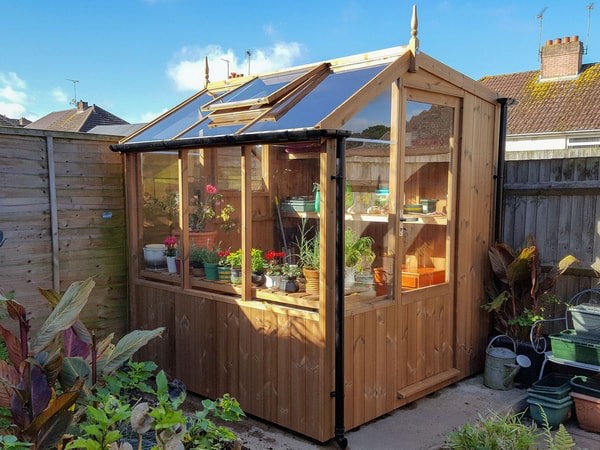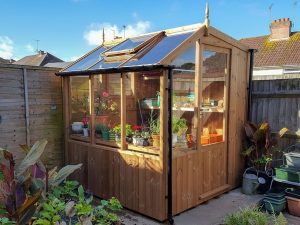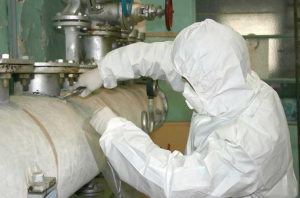Find Your Perfect Greenhouse for Sale

Greenhouse gardening is seeing a surge in popularity, with a market growth projection of 8.5% annually. More and more people are discovering the joy of cultivating their own plants, vegetables, and flowers year-round. If you’re looking to join this green-thumbed community, one of the first steps is choosing the right structure. But with so many types of greenhouses for sale, how do you know which one is best for you?
This guide will walk you through the various options available, breaking down the materials, styles, and benefits of each. We’ll explore the latest trends and answer your most pressing questions to help you find a greenhouse that fits your space, budget, and gardening ambitions. By the end of this post, you’ll have the clarity needed to make an informed decision and start your gardening journey with confidence.
What Are the Most Popular Greenhouse Materials?
When shopping for a greenhouse, the materials used for the frame and covering (glazing) are critical factors. They determine the structure’s durability, insulation, light diffusion, and overall cost.
Framing Materials
The frame is the skeleton of your greenhouse, providing support and stability. Three primary materials are used in modern greenhouse construction.
Aluminum
Aluminum is by far the most popular choice for greenhouse frames, and for good reason. It is lightweight, strong, and resistant to rust and corrosion. This means it requires very little maintenance over its lifespan. Aluminum frames can be powder-coated in various colors to match your garden aesthetic. Because of its strength, it can be made into thin profiles, maximizing the amount of sunlight that enters the greenhouse. Statistics show that homeowners often prefer low-maintenance solutions, and aluminum’s durability fits this trend perfectly.
Steel
For those seeking maximum strength and durability, galvanized steel frames are an excellent option. Steel is heavier and stronger than aluminum, making it ideal for larger greenhouses or for use in areas that experience heavy snow or high winds. The galvanization process protects the steel from rust, ensuring a long service life. While typically more expensive than aluminum, the added strength provides peace of mind in harsh weather conditions.
Wood
Wooden frames offer a classic, traditional aesthetic that many gardeners find appealing. They can blend beautifully into a natural garden setting. Common wood types include cedar and pressure-treated pine, which are chosen for their natural resistance to rot and insects. Wood is also a good insulator. However, wood frames require more maintenance than metal ones. They may need to be treated, stained, or painted periodically to protect them from the elements and prevent decay, which is a key consideration for long-term upkeep.
Glazing (Covering) Materials
Glazing is the transparent material that covers the frame. Its primary job is to let in sunlight while providing insulation.
Polycarbonate
Polycarbonate is now the most common glazing material for home greenhouses. It is a rigid, twin-wall plastic that is virtually unbreakable. This makes it a much safer option than glass, especially if you have children or pets. Polycarbonate provides excellent insulation due to the air pockets between its two walls, which helps maintain a more stable temperature inside the greenhouse. It also diffuses light, which prevents plants from getting scorched by direct sun and ensures light reaches all parts of the plant. It’s a top choice for gardeners prioritizing safety and thermal efficiency.
Glass
Glass is the traditional choice for greenhouse glazing. It offers the highest level of light transmission and is visually stunning. Toughened safety glass is now standard for most glass greenhouses, reducing the risk of injury from breakage. While glass has a very long lifespan and doesn’t yellow over time like some plastics, its main drawback is its lower insulation value compared to twin-wall polycarbonate. It is also heavier and more fragile, often resulting in a higher initial cost for both the material and the installation.
Polyethylene Film
Polyethylene film is a flexible plastic sheeting used primarily for hoop houses or less permanent structures. It is the most affordable glazing option and is easy to install and replace. UV-stabilized films can last for several years. While it doesn’t offer the same level of insulation or durability as polycarbonate or glass, its low cost makes it a popular choice for beginners or those with large areas to cover on a tight budget.
What Greenhouse Styles Are Available?
Beyond materials, greenhouses come in different shapes and styles. Each design offers unique benefits related to space, airflow, and aesthetics.
Freestanding Greenhouses
A freestanding greenhouse is a standalone structure that can be placed anywhere in your yard that receives adequate sunlight. This is the most traditional style.
Traditional or A-Frame
This classic design, shaped like a house with a peaked roof, is excellent for shedding snow and rain. The high roof provides ample headroom and space for tall plants or hanging baskets. Good ventilation is often achieved through roof vents and side vents. This style is one of the most popular, accounting for a significant portion of the residential greenhouse market.
Barn-Style
Barn-style or gambrel-roof greenhouses have a distinctive two-sided roof with a shallow upper slope and a steeper lower slope. This design maximizes interior headroom and usable space, making it feel very spacious inside. It’s a great choice if you plan to spend a lot of time working in your greenhouse or want to grow very tall plants.
Geodesic Dome
A geodesic dome greenhouse is a spherical structure made of many small triangular panels. This design is incredibly strong and wind-resistant. The dome shape allows for even light distribution throughout the day as the sun moves across the sky. It also promotes excellent air circulation, which helps maintain a consistent temperature. Dome greenhouses are a modern, eye-catching option that is both functional and beautiful.
Attached Greenhouses
An attached or lean-to greenhouse is built against an existing wall of your home or garage. This style is a fantastic space-saver for smaller yards.
Lean-To
A lean-to greenhouse shares one wall with your house, which has several advantages. The shared wall can absorb heat from the sun during the day and radiate it back into the greenhouse at night, helping to stabilize temperatures. It also allows for easy access to electricity and water from your home. This convenience is a growing trend, as more urban gardeners look for integrated solutions. Lean-to models are perfect for those who want a greenhouse but have limited space.
What Are the Benefits of Owning a Greenhouse?
The trend toward home gardening isn’t just about aesthetics; it’s about the tangible benefits a greenhouse can bring to your life.
Extend Your Growing Season
This is perhaps the biggest benefit. A greenhouse allows you to start planting earlier in the spring and continue harvesting later into the fall. In many climates, you can even grow certain crops year-round. This means fresh, homegrown produce is available for more months of the year.
Grow a Wider Variety of Plants
With a controlled environment, you can cultivate plants that wouldn’t normally survive in your local climate. Fancy growing exotic fruits, tropical flowers, or specific herbs? A greenhouse makes it possible by allowing you to manage temperature, humidity, and light.
Protect Plants from Pests and Weather
A greenhouse acts as a physical barrier, protecting your precious plants from common garden pests like rabbits, deer, and many insects. It also shields them from harsh weather, including heavy rain, hail, strong winds, and late frosts, which can devastate an outdoor garden.
Enjoy Gardening Year-Round
For many, gardening is a therapeutic and enjoyable hobby. A greenhouse provides a sheltered, comfortable space to indulge in your passion regardless of the weather outside. It can be a peaceful retreat during the cold winter months.
Increase Your Property Value
A well-constructed and maintained greenhouse can be an attractive feature that adds value to your property. It signals a well-cared-for home and garden, which is a positive attribute for potential buyers.
Your Path to a Greener Garden
Choosing the right greenhouse is a significant step toward creating the garden of your dreams. By considering the different materials like durable aluminum frames and insulating polycarbonate panels, and by exploring styles from classic freestanding models to space-saving lean-to designs, you can find the perfect match for your needs. The growing trend of home cultivation is more than a fleeting interest; it’s a movement toward a more sustainable and rewarding lifestyle. A greenhouse is an investment that pays dividends in fresh produce, extended growing seasons, and the simple joy of gardening.
Take the time to assess your space, budget, and gardening goals. With the right information, you are now equipped to select a greenhouse that will serve you well for years to come, allowing you to unlock your garden’s full potential.




